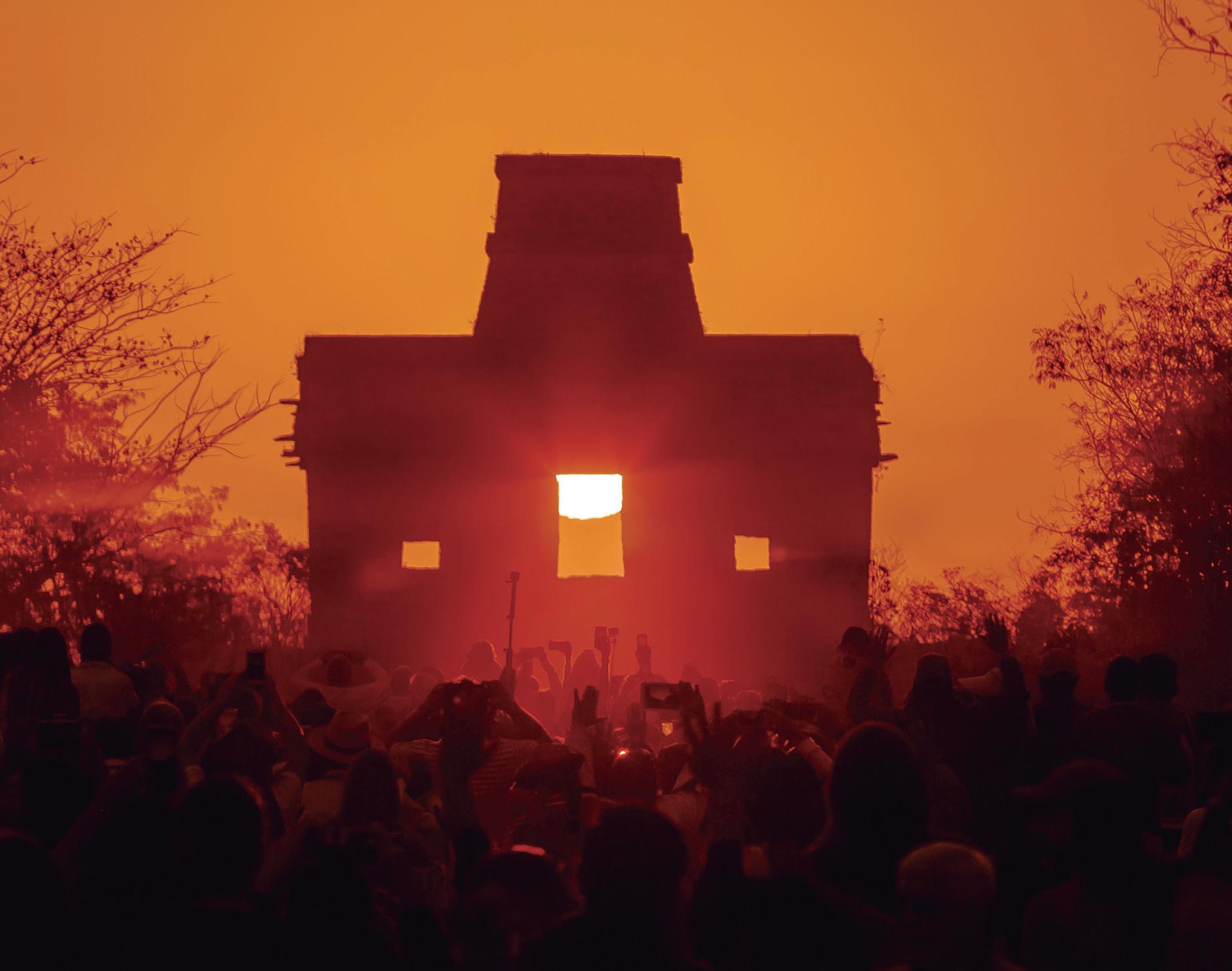
4 minute read
CoverPortada
EQUINOCCIOS SPRING EQUINOXES DE PRIMAVERA

Advertisement
Considerado como un evento que indicaba el inicio de un nuevo ciclo de tiempo para los antiguos mayas, el equinoccio es un fenómeno astronómico que sucede dos veces al año y en dos lugares diferentes en Yucatán: Dzibilchaltún y Chichén Itzá. El fenómeno enfatiza el carácter divino impregnado en la cosmogonía maya, en el que el equinoccio de primavera era interpretado como el inicio de la temporada de siembras, mientras que el inicio de la cosecha era en el equinoccio de otoño.
Considered an event that signaled the start of a new cycle of time for the ancient Maya, the Equinox is an astronomical phenomenon that occurs twice a year and at two different places in Yucatán: Dzibichaltún and Chichén Itzá. The phenomenon emphasizes the divine character steeped in Maya cosmogony in which the spring Equinox was interpreted as the start of the season of planting, while the autumn Equinox marked the beginning of the harvest.
CHICHÉN ITZÁ
Ubicada a 110 kilómetros de Mérida, esta zona arqueológica, fue una antigua ciudad maya que amalgama religión, guerra y comercio; su nombre se traduce como “boca de pozo” y tuvo su resplandor entre los años 900 y 1200 d.C. De ella se desprende “La Serpiente Emplumada” en el Castillo de Kukulkán, lugar donde se da el equinoccio entre las 3:00 y 4:00 de la tarde, el cual comienza cuando el sol da un viaje elíptico atravesando el Ecuador del hemisferio oriente al occidente.
El equinoccio se manifiesta en el Castillo, mediante la magia proyección de triángulos de luz y sombra del cuerpo de una serpiente, que se dibujan en el costado de la escalinata norte, complementado con las efigies de cabezas de serpiente emplumada que se encuentran en las bases. Lo maravilloso del fenómeno es que en el punto noreste se encuentra en la dirección exacta de cenote sagrado de Chichén Itzá, sitio por el cual Kukulkán descendía por el tributo.
Located 110 kilometers (72.3 miles) from Mérida, this archaeological area was an ancient Maya center that fused religion, war, and trade. Its name translates as “Mouth of the Well,” and it reached its zenith between 900 C.E. and 1200 C.E. From this, the Castle of Kukulkán, meaning “the plumed
Estos fenómenos suceden del 20 al 23 de marzo, siendo el 21, al amanecer, el día más esperado por ser el inicio de la primavera.
These phenomena occur from March 20 to 23, with the 21, at dawn, being the most anticipated day as it is the beginning of spring.
DZIBILCHALTÚN
Situada a 21 kilómetros al noroeste de Mérida, esta zona arqueológica fue un antiguo centro ceremonial maya que, de acuerdo con los especialistas, tuvo su época de mayor esplendor entre los años 600 y 1000 d.C. Su nombre significa “donde hay estructuras sobre las piedras planas”, y es ahí donde los visitantes pueden ser testigos de uno de los fenómenos astronómicos más importantes del mundo maya. A partir de las 5:00 de la mañana, abren la zona arqueológica para esperar la aparición del sol por el oriente. Poco a poco, a través de las ventanas y puertas del llamado “Templo de las Siete Muñecas”, llamado así porque justo debajo de su cámara principal se encontró una ofrenda que contenía siete figuras de barro con forma humana, se puede observar

la silueta del astro rey que va avanzando hasta colocarse justo detrás del centro del edificio. Lo anterior permite al espectador, presenciar una asombrosa imagen del sol y su resplandor atravesando y enmarcando el templo, en un espectáculo que, de modo exacto, indicaba a los mayas, entre otras cosas, el cambio de estación y la llegada de la primavera o el otoño.
Located 21 kilometers (13.8 miles) northwest of Mérida, this archaeological area was an ancient Maya ceremonial center that, according to the authorities, had its period of greatest splendor between 600 C.E. and 1000 C.E. (Note: Anno Domini, A.D., has been replaced with Common Era, C.E.) Its name means “Where there are structures on the flat stones.” It is here where visitors can witness one of the most important astronomical phenomena of the Maya world. It all begins around 5 AM when the sun makes its first appearance in the east. Little by little, through the windows and doors of the so-called “Tempo of the Seven Dolls,” (so named because just below the principle chamber seven clay figurines in human form were found), you can see the silhouette of the Astro king progress up to be positioned just behind the center of the building. This allows visitors to witness a stunning image of the sun and its rays shine through and frame the temple. It is a spectacle of precise moment and demonstrated to the Maya the change of season and the arrival of spring or autumn, among other things.
serpent,” culminates. It becomes a place where the Equinox can be viewed. It begins when the sun moves in an elliptical journey, crossing the Equator of the hemisphere East to West. The Equinox manifests itself in the Castle, through the magic of projection triangles of light and shade of the outline of a serpent, which are illuminated on the side of the north staircase. This is complemented by the carvings of plumed snake-heads that are found in the base of the pyramid. The wonderful thing of this phenomenon is that it points to the northeast, which is the exact direction of Sacred Well at Chichén Itzá, the place where Kukulkán descends to receive his tribute.






